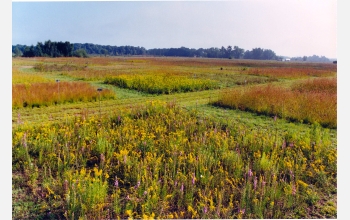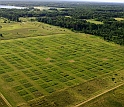News Release 06-092
Ecosystems With Many Plant Species Produce More and Survive Threats Better
Prairie plants may also be good source of biofuel

This experimental plot is planted with four species of flowering prairie plants known as forbs.
May 31, 2006
This material is available primarily for archival purposes. Telephone numbers or other contact information may be out of date; please see current contact information at media contacts.
Ecosystems containing many different plant species are not only more productive, they are better able to withstand and recover from climate extremes, pests and disease over long periods, according to a new study. It is the first experiment to gather enough data--over a sufficient time and in a controlled environment--to confirm a 50-year scientific debate about whether biodiversity stabilizes ecosystems.
The findings, published in this week's issue of the journal Nature, are the result of 12 years of experiments conducted by David Tilman, an ecologist at the University of Minnesota, and colleagues Peter Reich of the University of Minnesota and Johannes Knops of the University of Nebraska. The research was conducted at the Cedar Creek Long-Term Ecological Research (LTER) site, one of 26 such National Science Foundation (NSF) sites.
"This study clearly demonstrates that stability of a plant community through time increases as species richness goes up," said Martyn Caldwell, program director in NSF's Division of Environmental Biology, which funded the research. "Only a long-term field experiment can provide this information."
Biodiversity of global ecosystems has decreased as global population has increased, said Tilman, because diverse ecosystems such as forests and prairies have been cleared to make way for agricultural fields, buildings and roads.
The research shows that ecosystems containing many different plant species are more productive than those containing only one species. A return to biodiversity may prove to be the key, Tilman and his colleagues believe, to meeting energy needs for the growing number of people on the planet and for restoring global ecosystems.
"Diverse prairie grasslands are 240 percent more productive than grasslands with a single prairie species," Tilman said. "That's a huge advantage. Biomass from diverse prairies can, for example, be used to make biofuels without the need for annual tilling, fertilizers and pesticides, which require energy and pollute the environment. Because they are perennials, you can plant a prairie once and mow it for biomass every fall, essentially forever," Tilman said.
The research was carried out in 168 plots, each of which was randomly planted with one to 16 perennial grasses and other prairie plants. Stability of plants in the plots depended upon diversity and root mass. Roots store nutrients and buffer against climate variations. Perennial prairie plants have far more root mass than crops such as corn, which must be replanted annually.
-NSF-
-
Individual plots in this aerial view of the experimental are 9 meters by 9 meters.
Credit and Larger Version
Media Contacts
Cheryl Dybas, NSF, (703) 292-7734, email: cdybas@nsf.gov
Related Websites
NSF LTER Network: http://www.lternet.edu
NSF Cedar Creek LTER Site: http://www.cedarcreek.umn.edu
The U.S. National Science Foundation propels the nation forward by advancing fundamental research in all fields of science and engineering. NSF supports research and people by providing facilities, instruments and funding to support their ingenuity and sustain the U.S. as a global leader in research and innovation. With a fiscal year 2023 budget of $9.5 billion, NSF funds reach all 50 states through grants to nearly 2,000 colleges, universities and institutions. Each year, NSF receives more than 40,000 competitive proposals and makes about 11,000 new awards. Those awards include support for cooperative research with industry, Arctic and Antarctic research and operations, and U.S. participation in international scientific efforts.
Connect with us online
NSF website: nsf.gov
NSF News: nsf.gov/news
For News Media: nsf.gov/news/newsroom
Statistics: nsf.gov/statistics/
Awards database: nsf.gov/awardsearch/
Follow us on social
Twitter: twitter.com/NSF
Facebook: facebook.com/US.NSF
Instagram: instagram.com/nsfgov

